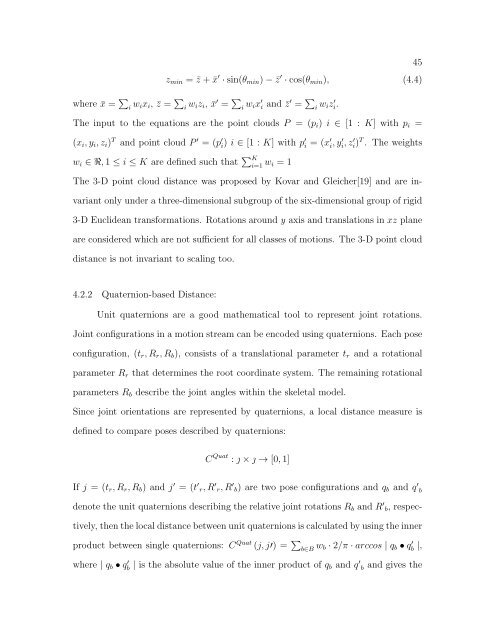A COMPARISON AND EVALUATION OF MOTION INDEXING ...
A COMPARISON AND EVALUATION OF MOTION INDEXING ...
A COMPARISON AND EVALUATION OF MOTION INDEXING ...
Create successful ePaper yourself
Turn your PDF publications into a flip-book with our unique Google optimized e-Paper software.
zmin = ¯z + ¯x ′ · sin(θmin) − ¯z ′ · cos(θmin), (4.4)<br />
where ¯x = <br />
i wixi, ¯z = <br />
i wizi, ¯x ′ = <br />
i wix ′ i and ¯z ′ = <br />
i wiz ′ i.<br />
The input to the equations are the point clouds P = (pi) i ∈ [1 : K] with pi =<br />
(xi, yi, zi) T and point cloud P ′ = (p ′ i) i ∈ [1 : K] with p ′ i = (x ′ i, y ′ i, z ′ i) T . The weights<br />
wi ∈ ℜ, 1 ≤ i ≤ K are defined such that K<br />
i=1 wi = 1<br />
The 3-D point cloud distance was proposed by Kovar and Gleicher[19] and are in-<br />
variant only under a three-dimensional subgroup of the six-dimensional group of rigid<br />
3-D Euclidean transformations. Rotations around y axis and translations in xz plane<br />
are considered which are not sufficient for all classes of motions. The 3-D point cloud<br />
distance is not invariant to scaling too.<br />
4.2.2 Quaternion-based Distance:<br />
Unit quaternions are a good mathematical tool to represent joint rotations.<br />
Joint configurations in a motion stream can be encoded using quaternions. Each pose<br />
configuration, (tr, Rr, Rb), consists of a translational parameter tr and a rotational<br />
parameter Rr that determines the root coordinate system. The remaining rotational<br />
parameters Rb describe the joint angles within the skeletal model.<br />
Since joint orientations are represented by quaternions, a local distance measure is<br />
defined to compare poses described by quaternions:<br />
C Quat : j × j → [0, 1]<br />
If j = (tr, Rr, Rb) and j ′ = (t ′ r, R ′ r, R ′ b) are two pose configurations and qb and q ′ b<br />
denote the unit quaternions describing the relative joint rotations Rb and R ′ b, respec-<br />
tively, then the local distance between unit quaternions is calculated by using the inner<br />
product between single quaternions: C Quat (j, j′) = <br />
b∈B wb · 2/π · arccos | qb • q ′ b |,<br />
where | qb • q ′ b | is the absolute value of the inner product of qb and q ′ b and gives the<br />
45
















